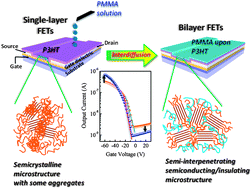Polymer bilayer films with semi-interpenetrating semiconducting/insulating microstructure for field-effect transistor applications†
Abstract
We report an unexpected improvement in the microstructural and electrical properties of regioregular poly(3-hexylthiophene) (P3HT) as an active layer in field-effect transistors (FETs) by introducing soft insulating chains from poly(methyl methacrylate) (PMMA) as a cover layer in a


 Please wait while we load your content...
Please wait while we load your content...